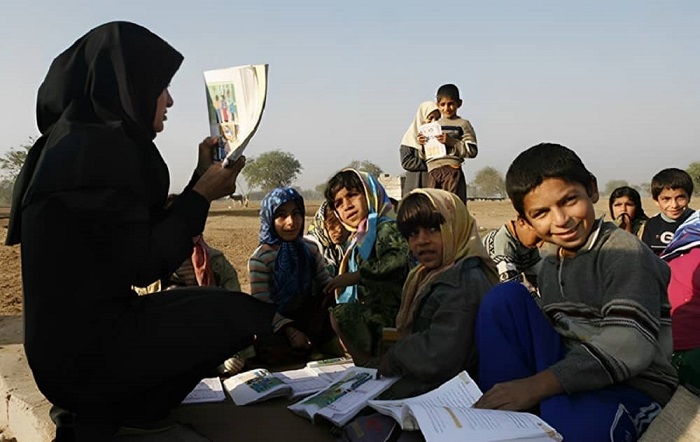
Despite Iran’s constitutional commitment to free education, recent trends suggest the nation is veering away from this pledge, leading to increased financial pressures on families and a widening educational gap.
Article 30 of the Iranian constitution clearly states: “The government is obligated to provide free education up to the end of secondary school for all citizens and extend higher education facilities for free up to the country’s self-sufficiency limit.” However, many citizens find this promise increasingly unfulfilled in practice.
Public schools, which were supposed to be free, now charge a minimum of 1,500,000 Iranian tomans for enrollment. Hossein Ali Haji Deligani, a parliament member, shed light on this issue, stating that many schools forcefully collect money for enrollment despite the law advocating for free education.
Cause of Rising School Dropouts in Iran
While children in #Iran commit suicide in Iran for not having access to a smartphone to continue their education, the regime continues funding terrorist groups. #NoImpunity4Mullahs #HumanRights https://t.co/sKPNrfzoGe
— NCRI-FAC (@iran_policy) April 11, 2021
President Ebrahim Raisi’s administration has plans to convert 25% of the country’s public schools into charter schools by March 2024. These institutions, while offering superior services, come with tuition fees. Furthermore, the 2024 academic year will see private school tuition ranging from 5 to 48 million tomans. Some elite institutions, providing extravagant services like foreign trips, can have tuition fees skyrocketing to a billion tomans annually.
As the regime prioritizes profit over education, luxury schools flourish, often situated in posh localities, managed by former education department leaders, making them susceptible to both corruption and regime influence. Meanwhile, disadvantaged children grapple with overcrowded classrooms, lack of basic amenities, and subpar emergency facilities.
#Iran News in Brief
While Iranian teachers are deprived from fair pay and millions of Iranian children from proper schooling, the regime’s Minister of Education announced today that AEOI has allocated €1.5M for nuclear activities in Iranian #schools.https://t.co/SfL7mZIVhF pic.twitter.com/0B8PtNovIw
— NCRI-FAC (@iran_policy) June 3, 2022
The steep rise in stationery prices, an increase of 60% in 2023 due to inflation, further adds to the strain on families. Basic items like colored pencils and watercolors now verge on being considered luxuries.
These burgeoning costs have steered Iranian students away from classrooms and towards the challenging job market. Shockingly, over the last two academic years, approximately 5 million students have dropped out or couldn’t attend school.
When juxtaposed with 13 neighboring countries, Iran’s investment in education paints a grim picture. The nation allocates just 3.9% of its total budget to education, a mere $4.44 billion, while countries like Japan, the USA, and the UK invest vastly more significant amounts.
MOST TEACHERS LIVE UNDER THE POVERTY LINE
In light of the economic situation in #Iran,the min.monthly expenses for a family of4 in April2019 was 8million tomans ($700).While the min. wage is 1517K tomans ($132).The photo below refers to the teacher's protests objecting low pay: pic.twitter.com/IFs1I8Mx5P— NCRI-FAC (@iran_policy) September 23, 2019
A telling figure emerges when examining the ‘student per capita’ spend. Iran spends approximately $338 per student annually. In comparison, Japan spends $16,326, and even Turkey allocates $1,800. On average, the world spends $9,313 per student, nearly 30 times Iran’s expenditure.
Former Minister of Education, Yousef Nouri, revealed an alarming statistic: almost 9 million Iranians are illiterate, over 10% of the nation’s population. The number of children not receiving primary education has risen since 2016, further widening the educational gap.
The education system is declining every day under the mullahs’ rule. Several million students are left out of school due to extreme poverty. The number of illiterates has surged to include at least 4 million child laborers.#LiteracyDay https://t.co/cjKgFnCtda pic.twitter.com/BE3wthZ7BW
— Maryam Rajavi (@Maryam_Rajavi) September 8, 2022
Countries globally recognize the undeniable correlation between education and economic prosperity. Yet, Iran’s regime seems to prioritize self-preservation over its citizens’ educational welfare, viewing schools as mere profit centers.

MEK Iran (follow us on Twitter and Facebook), Maryam Rajavi’s on her site, Twitter & Facebook, NCRI (Twitter & Facebook), and People’s Mojahedin Organization of Iran – MEK IRAN – YouTu
